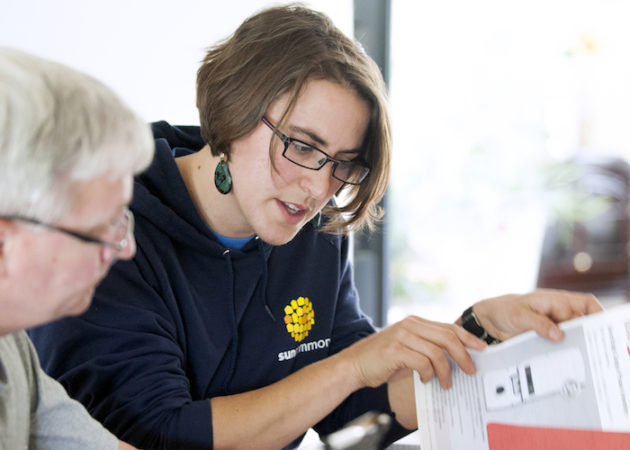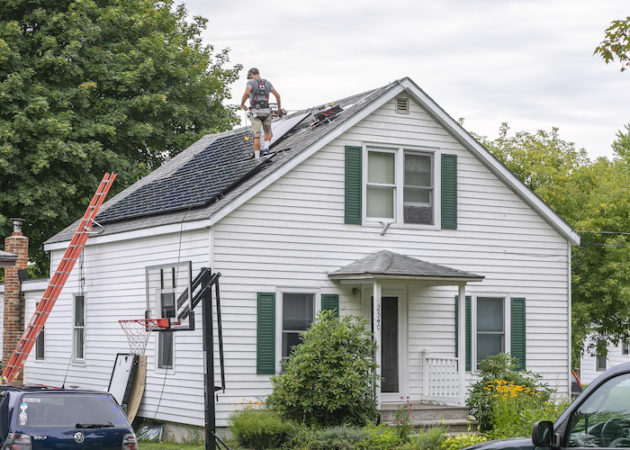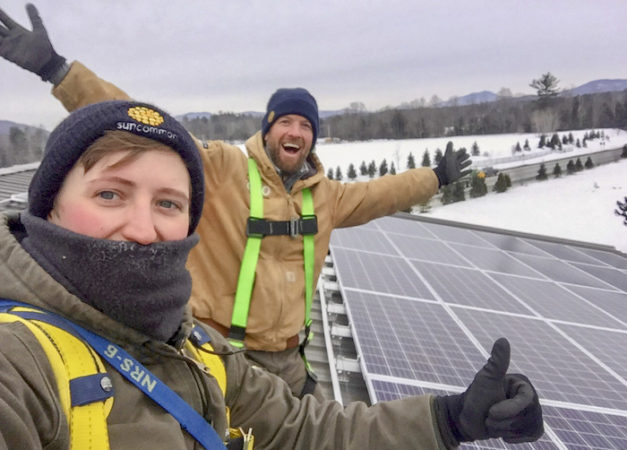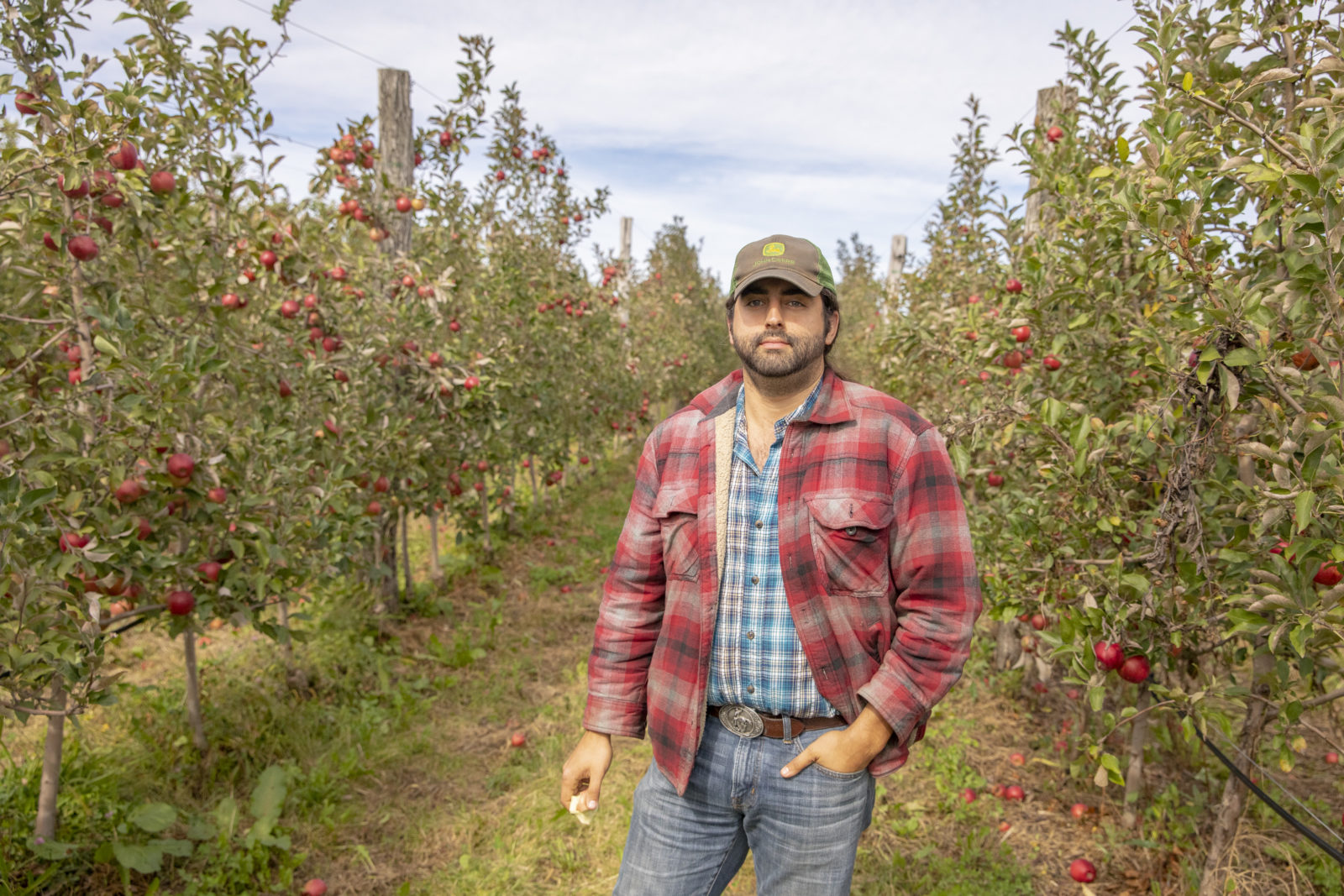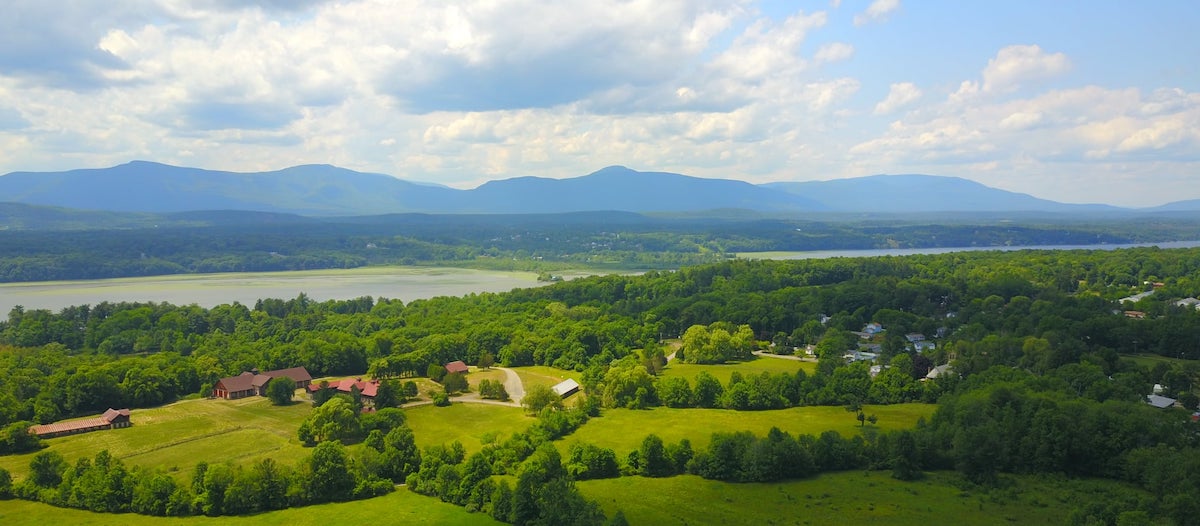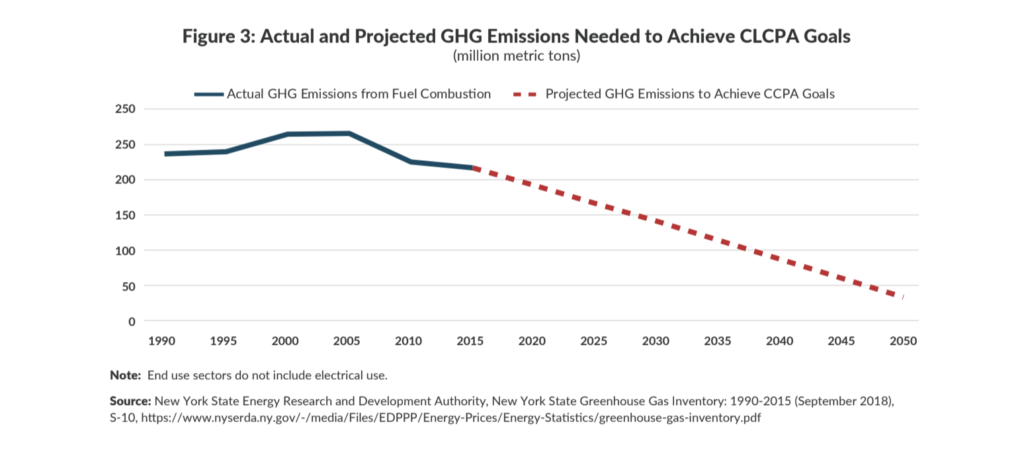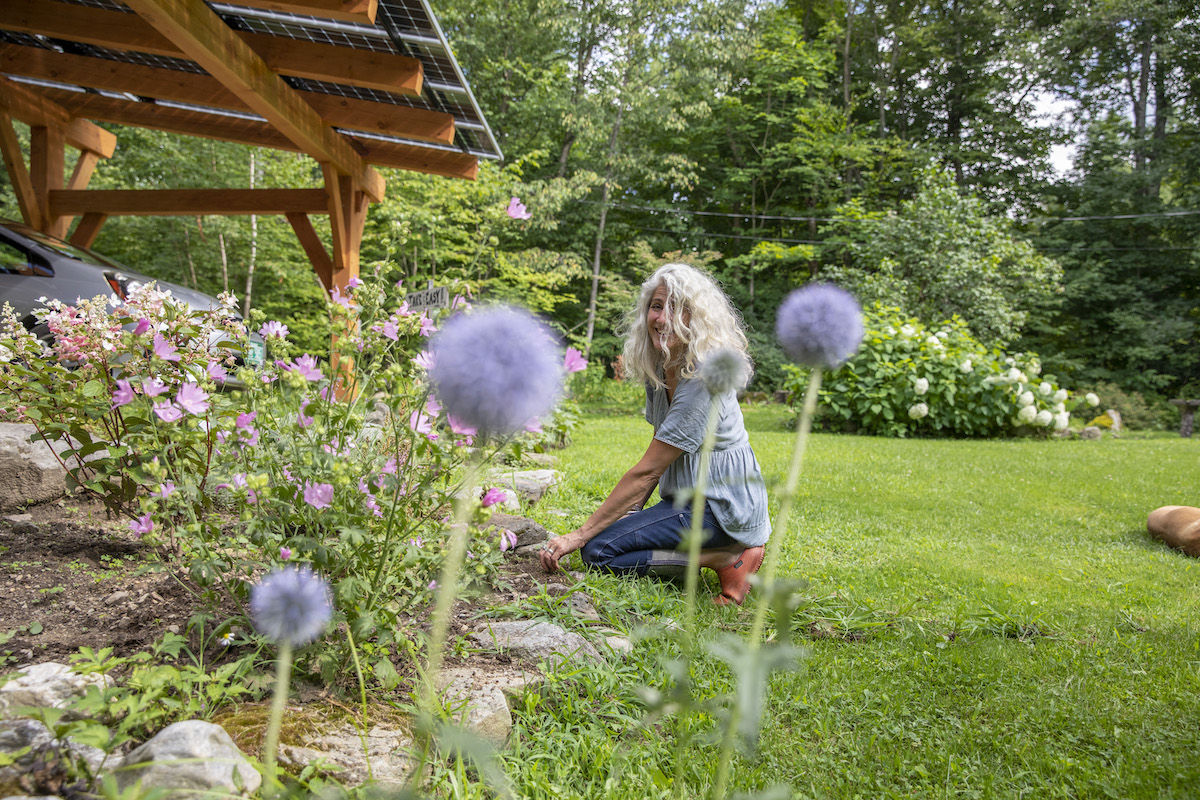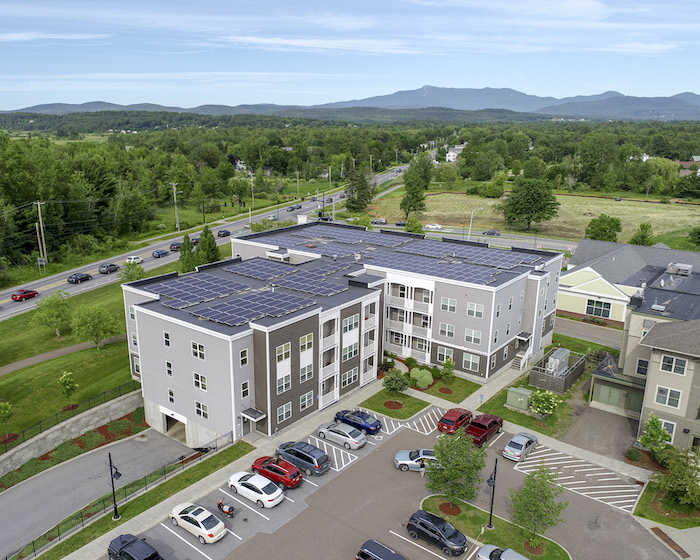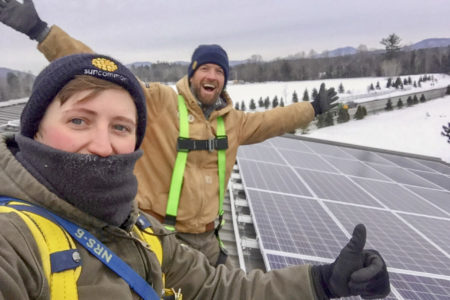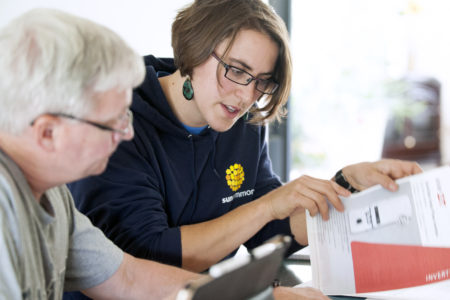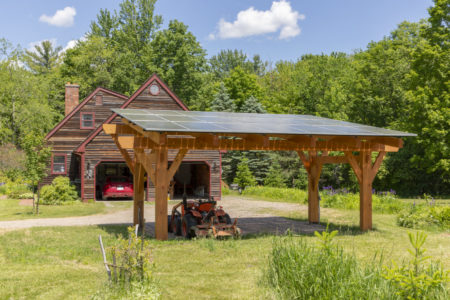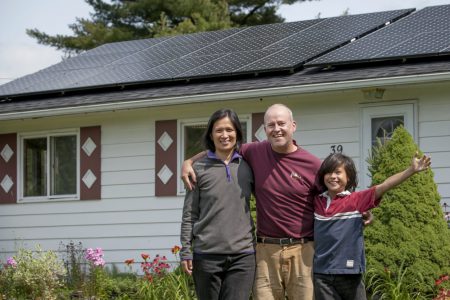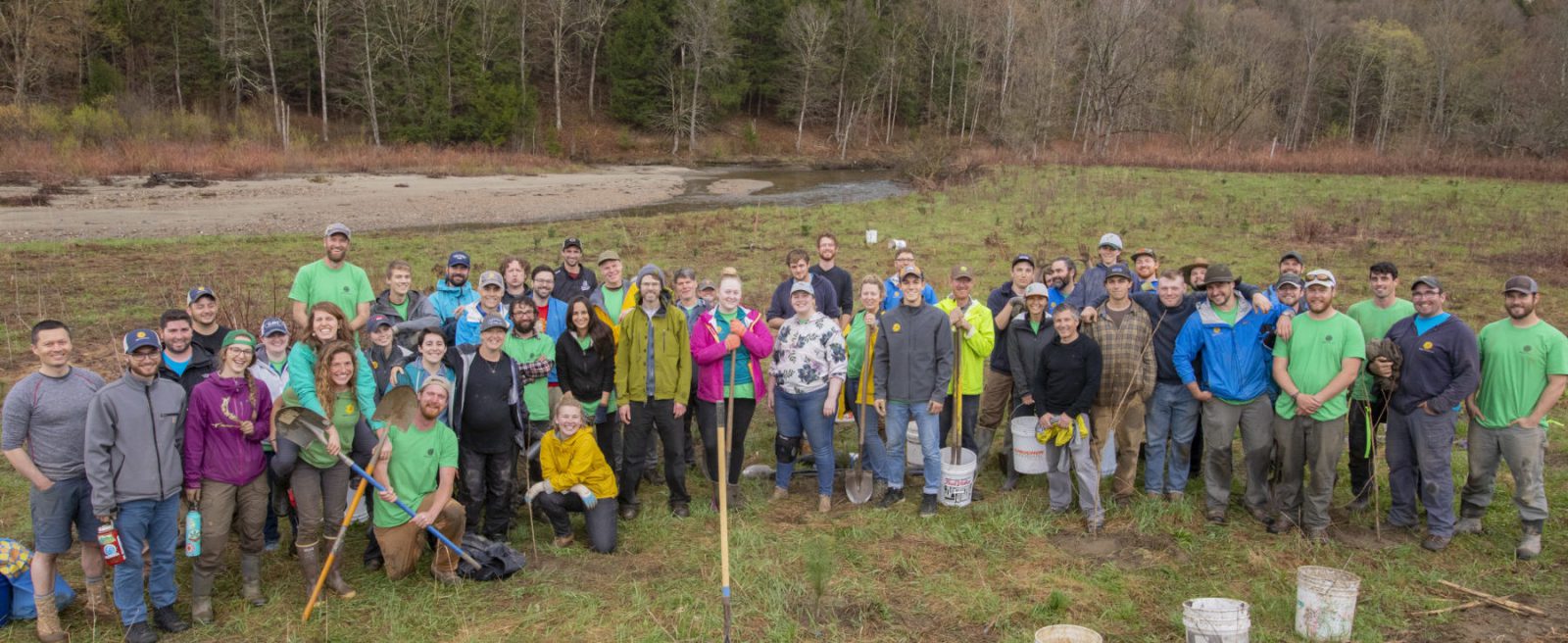How to Make a Solar-Powered Gingerbread House
So how do you make a gingerbread house that will have the lowest carbon impact on the ginger-environment? Let’s start with the basics: Building a gingerbread house with solar panels. This recipe is provided by our friends at King Arthur Flour, a fellow B Corp.
Ingredients
Dough
☐ 6 tbsp butter
☐ 3/4 cups buttermilk
☐ 1 cup brown sugar
☐ 1/2 cup molasses
☐ 1 large egg
☐ 5 cups Unbleached All-Purpose Flour
☐ 1 tsp baking soda
☐ 1 tsp ground ginger
☐ 1 tsp ground cinnamon
☐ 1/2 tsp salt
Royal Icing
☐ 3 egg whites
☐ 1/2 tsp cream of tartar
☐ 4 cups unsifted confectioners’ sugar
☐ Food coloring as desired
Instructions
To make the dough
1. In a large saucepan, heat the buttermilk and butter until the butter is just melted; remove from the heat.
2. Add the brown sugar and molasses, then beat in the egg.
3. Whisk the baking soda, spices, and salt with 1 cup of the flour.
4. Add this to the wet mixture and incorporate.
5. Add flour 1 cup at a time until you have a smooth, stiff dough. It should be stiff enough to be flexible, and neither crumbly nor sticky.
6. Divide the dough in half, flatten each half, and wrap in plastic. Refrigerate for at least 1 hour.
7. Preheat the oven to 350°F. 8. Using a quarter of the dough at a time (return the unused portion to the refrigerator), roll the dough 1/8” thick on a piece of parchment.
9. Cut your construction pieces as needed, pulling away the scraps to be re-rolled. Transfer the dough, parchment and all, to a baking sheet.
10. Bake for 10 to 12 minutes, until set and very lightly browned at the edges.
11. Remove from the oven and trim any rough edges while the pieces are still warm. Cool completely before using for construction.
To make the royal icing
1. In a large bowl, whip the egg whites with the cream of tartar until foamy.
2. Sprinkle in the sugar gradually, whipping all the while. The more you whip the icing, the stiffer it’ll be and the faster it’ll harden up.
3. Cover the bowl of icing, taking out only as much as you’ll need immediately. The easiest way to store the icing for long periods of time is in a plastic pastry bag, or zip-top food storage bag.
How to make solar panels for your gingerbread house
Be creative! Here are some ideas to get you started:
- Melt blue peppermints, Jolly Ranchers, or another blue candy into squares
- Use blue and white frosting to “paint” the panels onto your ginger roof.
- Cut something sticky, like a Stroopwaffle, into rectangles and cover them in edible, colored glitter dust
- Place Hershey Bars on the ginger roof, then soften the chocolate with heat and add blue sugar dust.
Add clean technology to your gingerbread house
Want to get bonus points? Integrate other sustainable, carbon-saving technologies into your gingerbread house design. Here’s a list of our favorite sustainable tech!
Cold Climate Heat Pumps
Cold Climate Heat Pumps draw heat from the environment and moves it indoors to heat your home in the winter months. In the summer months it moves the heat outdoors to cool your home. Heat pumps are incredible efficiency – eliminating the need for burning fuel oil, reducing your environmental impact.
Tesla Powerwall Battery Storage
Wouldn’t it be great if we could take all the solar power generated from our solar panels and store it for later use? That’s exactly what the Tesla Powerwall does. Combined with on-site solar, this battery system gives homeowners peace of mind in the case of a power outage.
Geothermal Heating and Cooling
Geothermal energy is derived from the heat of the earth, and can be used to heat and cool homes. A home geothermal system is on a loop of circulated water buried deep underground, below the freeze line. In winter months, the water circulating absorbs the heat from the earth and is converted into heat for your home. 100% Emission Free. Pretty cool, right?
Insulation
A well insulated home can reduce energy consumption simply by keeping warm air in, and cold air out. Not all insulation is eco-friendly, so if you are considering an upgrade, take a second to read up on what the most sustainable materials are. Some really great recycled options are shredded denim and cork.
Insulated Windows
Windows often account for the most significant amount of energy loss in a home and upgrading to insulated windows can help to reduce that loss. Traditional single-pane windows are often drafty and heat transfer can happen easily. Insulated, double pane windows provide an extra barrier to the outdoors and can significantly improve your home’s energy efficiency.
Compost Bin
Nearly half of the solid waste produced globally is organic or biodegradable, however much of it ends up in landfills and produces the greenhouse gas methane. Composting at home can be an easy, and affordable way to make your home a little more sustainable.
Electric Vehicle and Charger
When charged with electricity from renewable sources, electric vehicles (EVs) are emissions free. With environmental benefits aside, federal and state incentives make EVs an attractive option when considering your next car purchase.
Residential Wind Power
Imagine the huge large-scale wind turbine, but shrunk down to fit at a home!


The rainstorm that rocked Vermont on Halloween last Thursday knocked out power for 115,000 people—more than one-sixth of the state’s population!
For the 1100 folks with a Tesla Powerwall, however, stored energy kept their appliances running and lights lit during the blackout. For a time, these homes were electricity islands.
Thanks to incentives and in-state utility programs, energy storage is accessible to more Vermonters than ever. Large batteries like the Powerwall allow people to store energy to use later, so that when big storms hit they can keep all the essentials running seamlessly.
“When I heard about the storm coming, I started saving some of my solar power to the batteries in the Powerwall.”
—Laura Cameron (solar since 2018)
Powerwall means you don’t need to schlep out to the garage to turn on the generator when the weather disconnects you from the grid. The battery, sensing an interruption, automatically starts filling in. Until the utility turns the power back on, you’re essentially running on your own personal microgrid!
“[My partner and I] are both in our sixties. We can’t go haul water from the brook, and a generator is getting harder to use. That’s why we got the Powerwall.
We’ve had seven short power outages since installation and we don’t even know it when it’s happening because the Powerwall just kicks in. It’s so seamless!”
—Mary Anne Gummere (solar since 2018)
Batteries mean greener power for all
During sweltering summer days, when the entire region is cranking the AC, electricity prices soar. Utilities need to buy power from expensive and dirty “peaker plants,” power plants that get turned on to meet extraordinary electricity demand.
On the hottest day of 2019, Vermont’s Green Mountain Power saved $900,000 in a single hour by abstaining from that power, drawing it instead from the hundreds of Powerwalls enrolled in its distributed energy storage program. That means lower electricity prices for everybody, fewer fossil fuels burned, and less stress on the connecting wires.
Thank you for your submission
Someone will be in touch shortly. If you would like to expedite the process of going solar, and get scheduled for a home visit, please click here to provide additional information about your home.
Tae Wills, our in-house Powerwall expert, weighs in on energy storage
What are the benefits of adding storage to solar?
The benefits are unquestionable. Having solar coupled with storage adds so many capabilities. One of the main features is that solar coupled with storage will keep the solar on in the event of a power outage, prolonging the life of the battery. It still makes me kinda giddy when we do an “off grid” test post-install and see solar powering a home, charging the battery, and the battery isn’t even having to discharge. Literally running your home off of energy from the sun. It seems so futuristic, and it amazes me.
Nestled in the rolling hills of Tivoli, New York, Mead Orchards grows a delicious crop of fruits and vegetables all year round. They’ve engineered each row of trees to soak up maximum sunlight, much like the SunCommon solar modules on their barn roof.
Now, Joe grows his produce with sunlight, and uses energy from the sun to keep it fresh.
Watch: Joe Nuciforo describes how we aligned energy needs with his core values and his lifelong pursuit of growing great apples.
“The way you lay out a modern apple orchard is actually all about light interception; how much sun you’re catching…. You talk about light interception harnessing the sun, this is what we’re already doing.”
—Joe Nuciforo


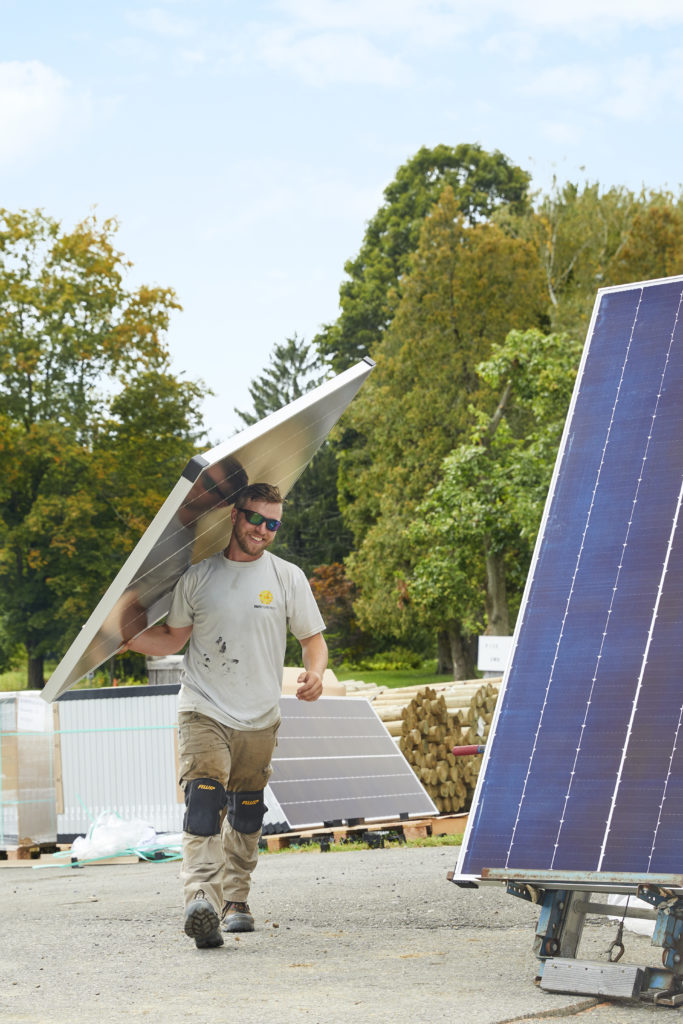

Solar is more accessible than ever
Solar isn’t just for big business, we’ve installed our fair share of small businesses too!
With all the tax incentives, savings, and (let’s be honest) brownie points you’ll get, commercial solar is a no brainer.
Want to learn more about solar?
We’re partnering with local affiliates of Habitat for Humanity this holiday season to use our business as a force for good—a key aspect of our mission—while supporting their mission to provide housing for folks in need.
We chose our partners, the Green Mountain and Dutchess County Habitat for Humanity affiliates, to support their remarkable work: Building high-efficiency, low-cost homes for low-income working families who live in substandard (unsafe/overcrowded/unaffordable) apartments and who can’t afford to buy a home on the open market. They build the homes using volunteers whenever possible (trained and supervised of course!) and sell the homes at the cost to buy the land and build the home.
SunCommon believes that everyone has the right to a healthy environment and a brighter future. For many, that means a safe and affordable place to live. With this in mind, SunCommon and our Habitat for Humanity partners have come together to help get more folks in a home they can call their own.
Because so many jobs are relatively low-wage, many people either pay more than 30% of their income on rent or live in unsafe/overcrowded apartments or live with family or friends. Living paycheck to paycheck, the “working poor” lack the opportunity to have a stable and healthy life and make tough decisions about how to buy necessities after paying their rent. Children are severely impacted by unsafe conditions and the need to move whenever the rent increases and have difficulties in school.
Benefits of Decent, Perpetually Affordable and Energy Efficient Housing
One of our partners, Green Mountain Habitat for Humanity, builds on average 6 homes a year for low-income working families who live in unsafe or unaffordable apartments and who can’t afford to buy a home on the open market. These homes are all built to be highly energy efficient homes, because spending less on energy gives each family more of their paychecks for food, education, medical and other necessities. Each home is certified by Efficiency Vermont and rated “Energy Star Certified”, “Indoor airPLUS Certified” and “Efficiency Vermont Certified, Level 2.0.”


All you have to do is look into solar with us this winter, and we’ll donate $20 to your local Habitat affiliate. Now is a great time to look into solar—get in before the end of the year and you’re eligible for a 30% federal tax credit!
Gingerbread Houses for Humanity
During the holidays, it’s easy to take the comfort of home for granted. But too many people go without stable housing situations. That’s why we’re partnering with Habitat for Humanity. For every person who signs up for a free solar assessment this holiday season, we will donate $20 to Habitat for Humanity. Habitat for Humanity builds high-quality, high-efficiency housing for people in need.
How to give:
Check out if solar works for your home by signing up for a free solar assessment.
We’ll donate to Habitat for Humanity to build housing for folks in need.
Enjoy your solar savings and feel good about building a more resilient community!
How You Can Help New York Reach Our Climate Goals
New York just committed to some pretty ambitious goals for us as a state through the recently passed Climate Leadership and Community Protection Act (CLCPA). There are three primary goals:
- Reduce greenhouse gas emissions to 60 percent of 1990 emissions levels by 2030
- Increase renewable energy to 70% of the energy mix by 2030
- Conserve 185 BTUs of heating energy
What’s inspiring is that there are actually things we can do to help out and make an impact on climate change. Let’s take a deeper look into the goals laid out by the CLCPA!
1. Increase renewable energy
The more renewable energy we can use, the less we have to rely on fossil fuels. Increasing emissions-free renewable energy is a key part of the climate crisis solution. And the CLCPA has set some pretty ambitious targets.
To meet the goal, the state expects 750,000 New Yorkers to go solar
The CLCPA specifically tasks us with adding 6000 megawatts (6 GW) of distributed solar (that means the smaller projects stuff that you install on your house or in small community arrays) by 2025. That’s 500,000 people going solar or joining their local community solar project, 750,000 by 2030.
Whoa that’s a lot. But there are a lot of people that live in New York State, too. Almost 20 million in fact. So it’s really just 2.5% of the population that needs to take action in the next five years. It’s totally do-able if we work together!
See if you can help meet our state goals!
Thank you for your submission
Someone will be in touch shortly. If you would like to expedite the process of going solar, and get scheduled for a home visit, please click here to provide additional information about your home.
2. Reduce greenhouse gas emissions
Greenhouse gases is what it’s all about, right? Too many of them are in the atmosphere and so let’s reduce the amount that we New Yorkers are putting in the air. This goal seeks to have us reduce what we are putting in the air to 60% of the 1990 level in just 11 years.
How can we ensure our emissions stay flat or decrease?
- Share rides and/or drive electric vehicles. Transportation is one sector in New York where carbon emissions are still steadily rising. You can help reduce the amount of gasoline burned in the state by carpooling whenever possible or, if you have the resources, driving on electricity!
- Use clean energy. When you go solar, either by getting panels on your roof or buying into a Community Solar Array, anything powered by electricity in your home is instantly emission-free.
- Conserving energy through efficiency. There are many ways to increase the efficiency of your home, many are also cost-effective because of the money they save you in the long-run. Insulating your house can not only reduce greenhouse gas emissions, but also the associated energy costs. Similarly, upgrading your water heater or switching out those old radiators for air-source heat pumps, will save your and the planet’s resources.
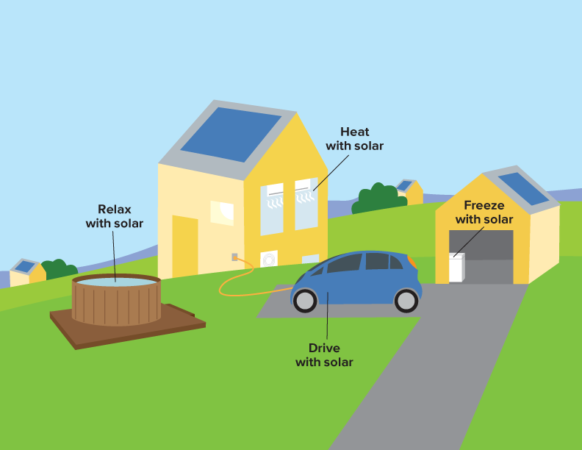

Interested in doing your part for the planet?
Want to learn more about solar?
Nicole is a SunCommon employee who just went solar. This is her story.
I’ve been fortunate to have traveled a lot. Around the world, I’ve seen incredible environmental degradation of all kinds— lack of infrastructure for proper waste disposal, no access to clean water or reliable electricity, burning trash and fossil fuel pollution from ancient vehicles.
While I’m not in a position to make systemic change in these places, I knew that back home my actions could have an impact.
When I returned home, I looked for a mission-driven organization, which is how I started working for SunCommon in March 2015.
Soon after, I became a member of one of their community solar arrays. I wanted my own panels someday, but in the meantime, I was supporting renewable energy and saved a bit on my electric costs too!
So how did I end up choosing the canopy?
Could I have found a cheaper renewable energy solution with another company? Perhaps. As a working single mom I certainly don’t have a disposable income.


I’ve been fortunate to have traveled a lot. Around the world, I’ve seen incredible environmental degradation of all kinds— lack of infrastructure for proper waste disposal, no access to clean water or reliable electricity, burning trash and fossil fuel pollution from ancient vehicles.
While I’m not in a position to make systemic change in these places, I knew that back home my actions could have an impact.
When I returned home, I looked for a mission-driven organization, which is how I started working for SunCommon in March 2015.
Soon after, I became a member of one of their community solar arrays. I wanted my own panels someday, but in the meantime, being a community solar member felt like a great way to support renewable energy, and hey, I saved a bit on my electric costs too!


SunCommon is all about accessibility.
The layout of my property and the forest behind my home, meant I couldn’t put solar on my roof or in the yard. However, my driveway and parking area had the best sun exposure.
Because of the numbers of trees I would need to cut down to go solar on my roof, I asked to see the numbers on the canopy; with the Federal ITC, and my decision to finance on my own (score another 8% cash discount!) my solar production from a canopy added up to significant savings.
I have instantly increased my property value. That investment alone is worth it.
SunCommon is all about accessibility.
The layout of my property and the forest behind my home, meant I couldn’t put solar on my roof or in the yard. However, my driveway and parking area had the best sun exposure.
Because of the numbers of trees I would need to cut down to go solar on my roof, I asked to see the numbers on the canopy; with the Federal ITC, and my decision to finance on my own (score another 8% cash discount!) my solar production from a canopy added up to a significant savings.
I have instantly increased my property value. That investment alone is worth it.


Plus, working with a company for my solar installation that is committed to being socially and environmentally responsible, was important to me.
As a Benefit Corporation and Certified B Corp, SunCommon aligns with my personal values and in ways that I want to move through the world.




I’m actually looking forward to winter this year, knowing my car will be more protected from the elements.
Being a community solar member was great, but producing clean energy right at home feels even better! More importantly, my daughter loves it too, given the context of climate change. She is used to me talking—okay, maybe preaching—about how important it is that we follow our values through with real actions.
We are both thrilled now to be doing even more, right here at home.
This Development Company Is Putting Solar On All Their New Buildings
Dousevicz Inc partnered with SunCommon on 4 multi-resident buildings and installed 530 kW of solar already, with plans for more.
Why? “It’s a no brainer,” Jed Dousevicz says.
The company knows that putting solar on a commercial development project will save them tens of thousands of dollars in energy savings over the lifetime of the system. All those savings mean more capital for future growth. It’s a virtuous cycle.
Watch the video below to learn more.


Solar is more accessible than ever
Solar isn’t just for big business, we’ve installed our fair share of small businesses too! Especially if you want to take advantages of the tax incentives you’ll get, solar really is a “no brainer.”
Are you looking for a locally owned senior independent living community powered by renewable energy?
Look no further, learn more about Williston Place.
“Plastic Free” is on everyone’s mind this month at SunCommon as the Plastic Free July campaign gets under way. We were stoked to join the movement to reduce pollution, reduce dependence on the petroleum industry, and conserve resources. But as we dug into ways we could support this cool campaign, we realized plastic use is not the cut and dry issue we thought it was!
I found it nearly impossible to go plastic free at my home.
Nearly every part of our day touches single-use plastic, whether it’s the cereal bag and the tube the toothpaste gets squeezed out of, all the way to the clothes we wear and our hobbies. Single-use plastic packaging is wrapped up in so many of our products and activities, it’s hard to avoid even if the product itself isn’t plastic.
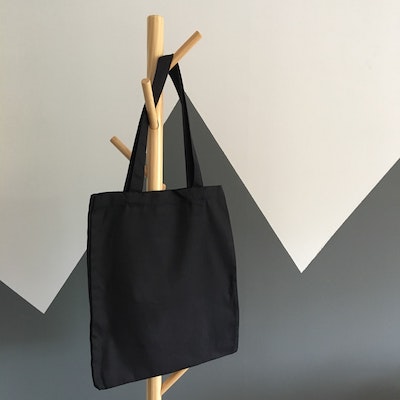

Here at SunCommon, I found the journey to be tricky too.
We tried to create a reusable shopping bag for our customers. Our first thought was a cute cotton tote bag, but turns out that cotton is incredibly resource hungry!
A study in Denmark looked at the overall resources necessary and the carbon footprint impact of common bag choices. An organic cotton tote bag requires enormous resources to produce. In theory, you use it a lot, so you can spread out that impact to multiple uses. But it takes so much energy to create a bag, that you have to reuse that bag 20,000 times to spread out the cumulative carbon impact of all those resources. Only then is the cotton tote bag’s carbon footprint less than a single-use plastic bag’s. That means you’d have to use your cotton tote bag every day for almost 55 years!
So that new cotton tote bag will reduce marine pollution, but sets us back in climate change.
Whoa – we were shocked. That wasn’t the answer we were looking for.
Recycling to the rescue
The bag we ultimately decided on is made of recycled materials by a fellow B Corp, Chico Bags. The materials they use don’t contribute to micro plastics in the ocean and they help turn a material that would have just been trash into something usable.
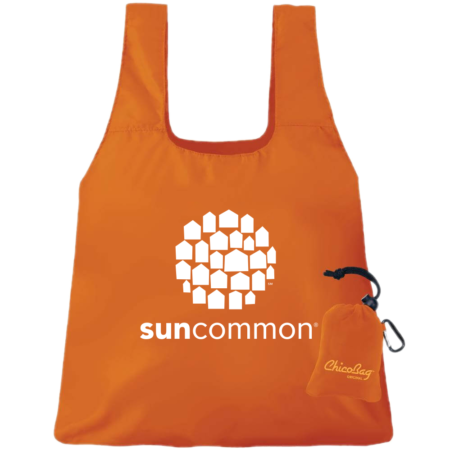

The more we dig into this issue, the more we find that re-using existing materials is a key part of the solution. So as you think about ditching plastic in July, think about what you can re-use or do without instead of buying something new. Instead of buying a brand new cotton tote bag, consider turning a worn out pair of jeans into a bag instead (there’s heaps of tutorials on how to do this!). Instead of replacing your plastic straw with a metal straw, forego a straw altogether.
These are small individual actions you can take in your own life. How can you help increase your impact? Consider reaching out to your favourite companies and asking them what they are doing to reduce plastic pollution or host a jeans-to-bag workshop in your own community.
1. Reusable To-Go Mugs
Maddy from our Digital Team runs on sunshine and frozen coffee. Her favorite way to be plastic-free is to bring in a reusable mug and straw to her favorite local coffee shop. They fill it up right there for her and even offer a discount for bringing a mug from home… Talk about a great way to help save the earth and a couple bucks!
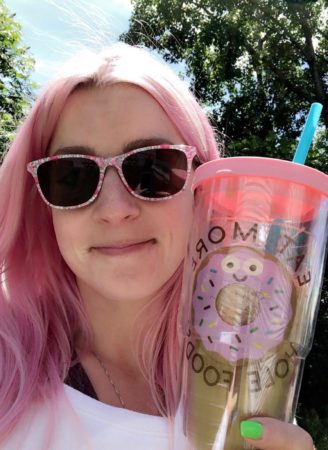

2. Buying in Bulk
Our Hudson Valley Storyteller, Adam Deen, supports a local market called Rolling Grocer. Their mission is to make wholesome food available to everyone in Columbia County at a fair price. To fulfill this goal, an unwavering commitment to environmental, social, and economic justice is essential.
Adam is a big fan of the bulk spice section, where single-use containers are a thing of the past!
Buying in bulk not only cuts down on waste, it’s usually cheaper too!
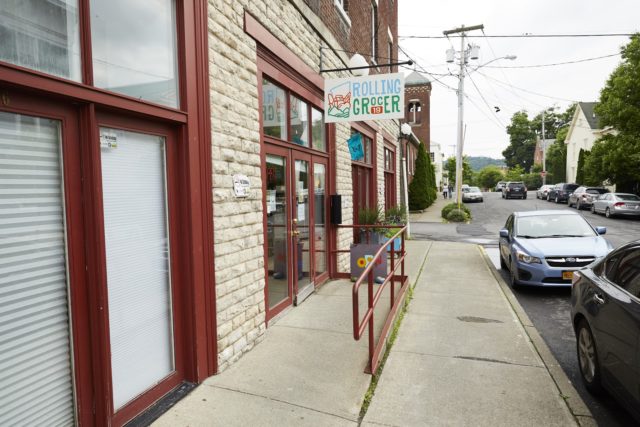

3. Beeswax Wrap
Our Creative Design Manager has been using Beeswrap for six or seven years. Eli writes, “It feels like such a natural part of life now. I love the versatility of it—from covering leftovers in the fridge to keeping bread fresh on the counter—and love that it lets me use way less plastic. Plus, it’s super easy to clean and very packable.”
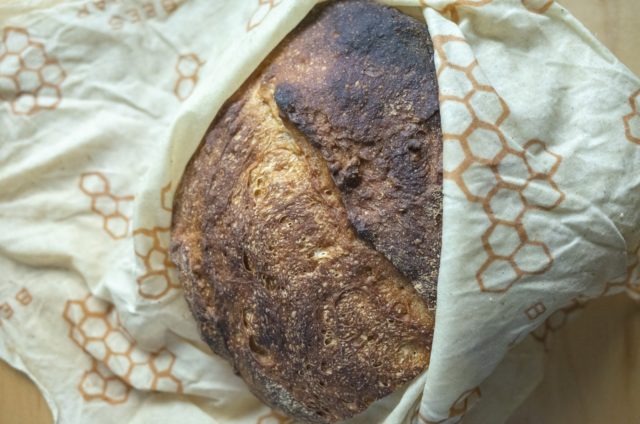

4. Silicone Covers
Speaking of baking bread, our digital team has been baking up a storm this year and keeping things plastic-free! When Patrick proofs his dough, he likes to keep a lid on things with silicone covers by Charles Viancin instead of using traditional plastic wrap.
“Keeping consistent temps while keeping out excess air is essential with dough, and I assumed plastic wrap was the right move for proofing. We had a few of these silicone covers for leftovers and found it to be a perfect substitute! Best of all, the excess dough that sticks to the top is easy to scrape off — not nearly as easy with wasteful plastic wrap.”
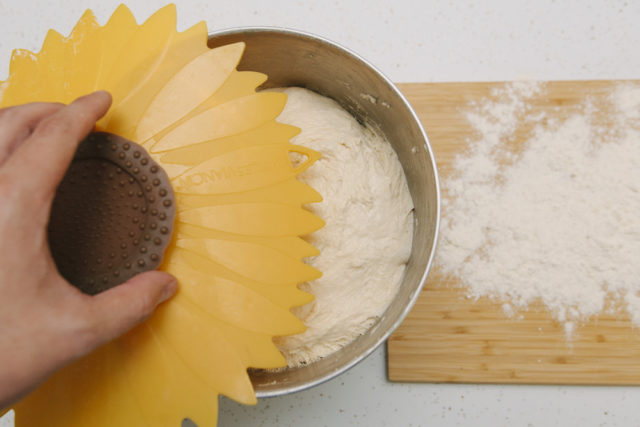

5. Travel-Ready Bamboo Utensils
Carrie from the Commercial Team never leaves the house without her handy-dandy bamboo utensil kit. She writes, “Even if I’m out to lunch with a friend, one of us takes the chopsticks and the other gets the fork. I’ve gotten way more use outta these than I ever expected, and they fit perfectly in my laptop bag!”


Our actions really do add up. Positive climate action starts individually and builds collectively. Get started. Share your progress. Be empowered to make a difference.
(Curious about Plastic-free July? Learn about it here.)
Why We Planted 1,200 Trees in One Day
On May 7, SunCommoners left our desks and job sites around the state, to spend the afternoon planting trees along the banks of the Winooski River. Why do that?
Sometimes when a fellow Vermonter asks us to install rooftop solar, we have to tell them: “To make solar work at your home, you’re going to have to cut down that tree shading your roof.” And over time, these trees add up. Even though the average solar system offsets about 50 times more carbon than a single tree would in its lifetime, we still miss those trees. So we decided to give back.
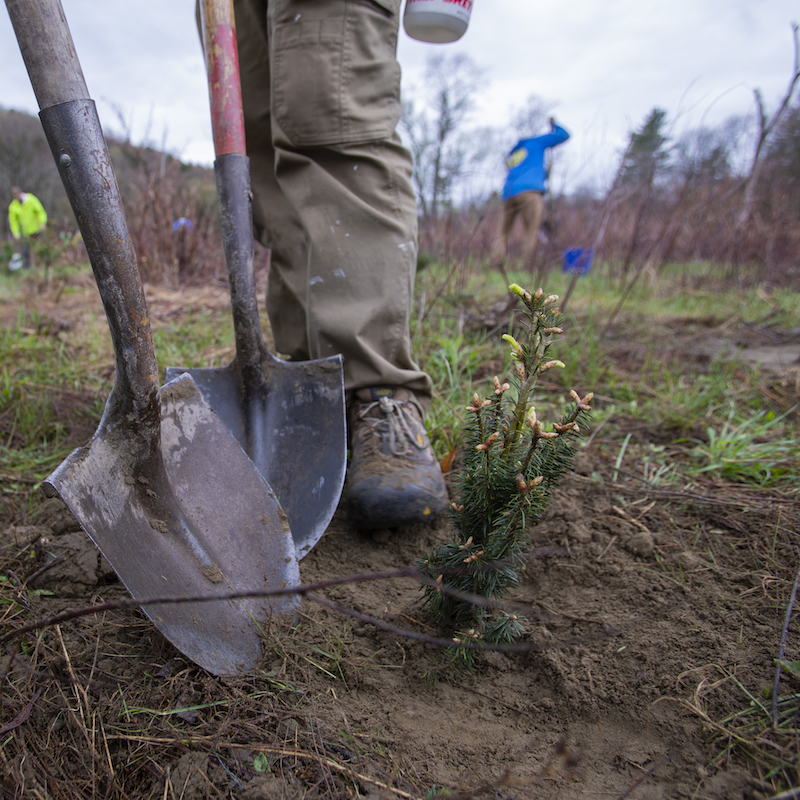

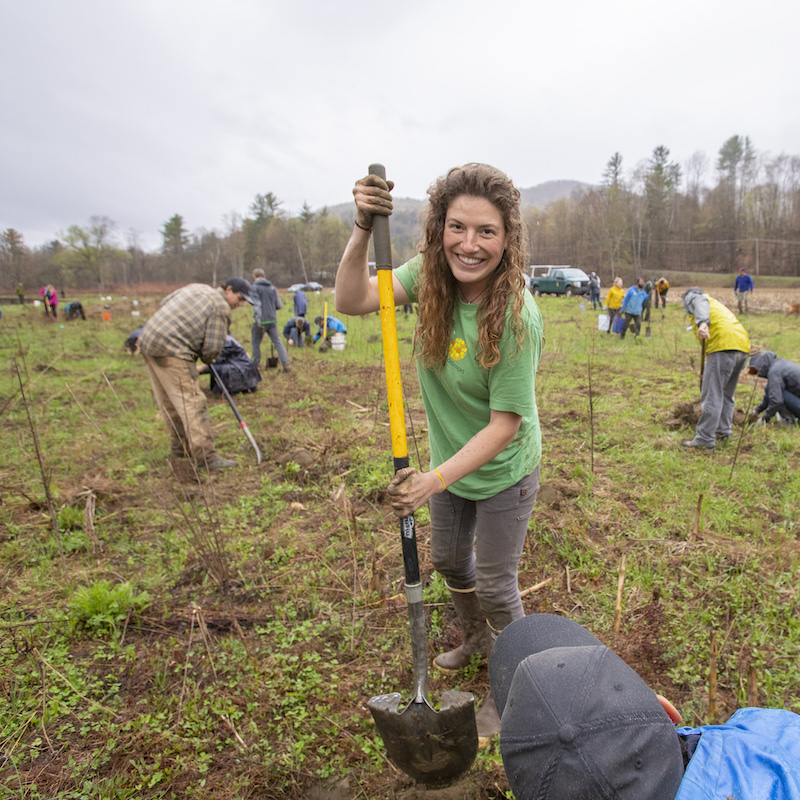

We worked with the Friends of the Winooski River (FWR) to plant native species along vulnerable riverbanks in Waterbury and Stowe. Due to deforestation in some places, there are no roots to hold the soil along the river in place, causing several feet of erosion per year!
It was a perfect partnership: The FWR needed help shoring up the riverbanks as quickly as possible and we needed to plant some trees.
Read their Open Letter below to learn more about the ecological benefits of planting trees.
Native Trees planted:
Shrub Willow, Silky Dogwood, Cottonwood, Nannyberry, Box Elder, Chokecherry, Tamarack, White Pine, Balsam Poplar, Staghorn Sumac, Elderberry, Balsam Fir, Red Maple, Sugar Maple
It seems like we did a good job!
We always support the involvement of volunteers for education and community engagement, but historically we have found them to reduce the pace of work instead of the other way around. From what our crew has said, the [SunCommon] volunteers were a different breed! If we didn’t already have a solar array, we’d be calling SunCommon.
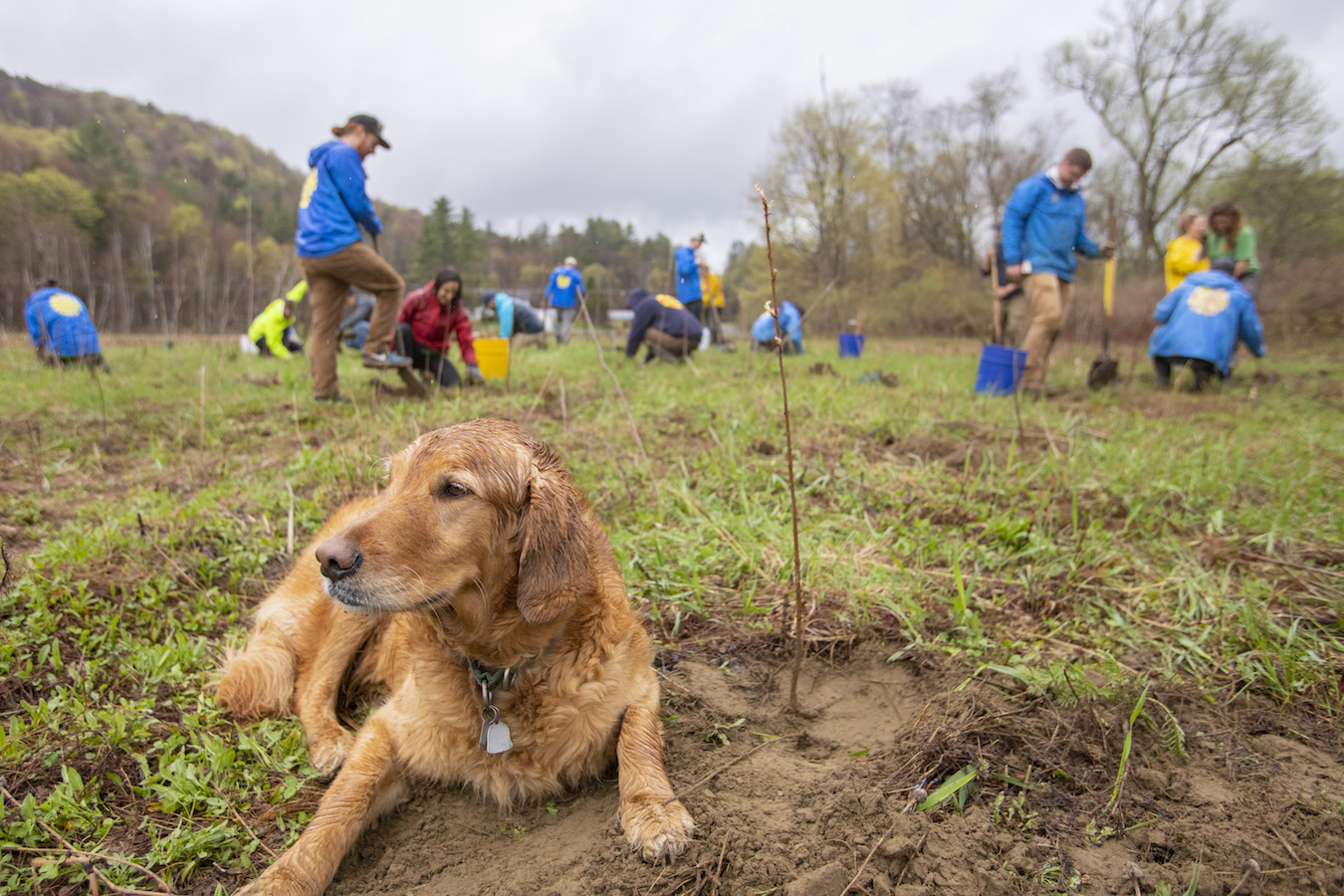

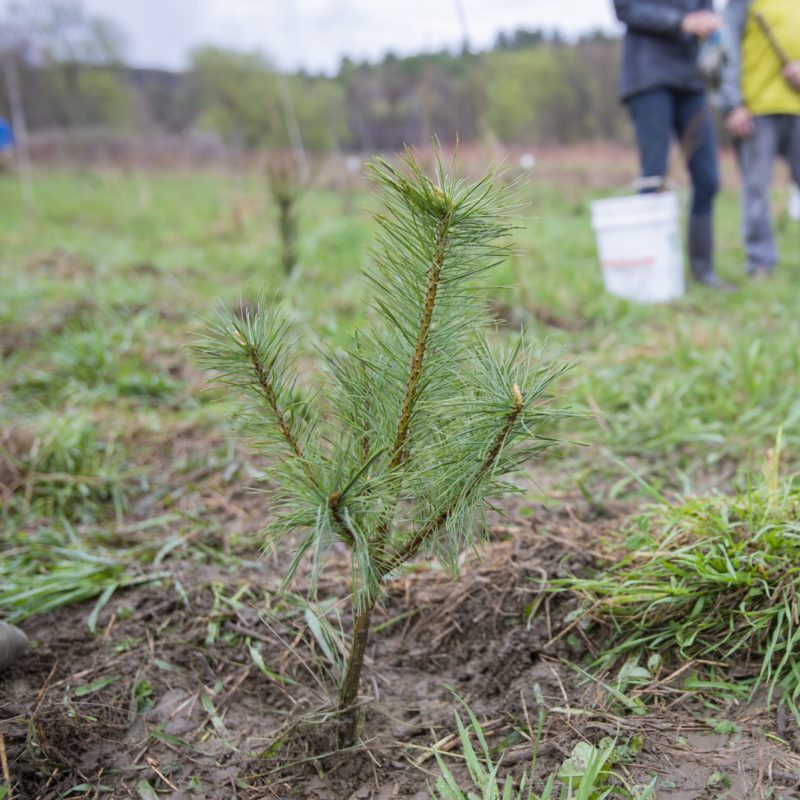

Did you know planting trees helps fish too?
Will Eldridge, aquatic habitat biologist at the Vermont Fish & Wildlife Department, explains:
It’s super important for the fish to have a forested riparian area. The trees around the stream provide a number of benefits: The roots help stabilize the bank; they help slow down erosion; keep sediment out of the rivers. They also, when they grow big, help shade the river, which is important for cold-water species like trout. They also can filter water and nutrients flowing over the land, like fertilizer and whatnot from the farm field, they can prevent that from entering the river. They also, when the trees fall in, they can provide habitat for fish and wildlife. So the trees actually become structures that fish will hide under. The leaves also provide food for bugs which the fish end up eating. So basically, as we like to say in the fisheries department, “fish grow on trees.”
An Open Letter from the Friends of the Winooski River
Dear Friends (of the Winooski River),
It’s no secret that Lake Champlain’s healthy ecosystem is vulnerable to impacts of those of us living, working and farming in its surrounding communities. Much of this comes as a result of the surplus sediment, toxins and also nutrients flowing into it from contributing rivers, such as the Winooski.
The Winooski watershed — all of the land area where water drains into the Winooski River — has the largest land area of any watershed in Vermont, home to about one quarter of the state’s population, covering all or part of more than 30 cities and towns. Friends of the Winooski River connects watershed residents with opportunities to spend time enjoying and restoring nature. One way to do that is to plant wide bands or buffers of native trees and shrubs along streams.
Planting trees and shrubs along streams provides a myriad of benefits!
- Trees and shrubs along streams help to slow rain as it flows over the land, which helps to maintain stable streambanks and protect downstream property.
- Woody vegetation has deep roots that hold soil in place and reduce erosion. This protects land and is critical to improving water quality in streams and in Lake Champlain.
- Overhanging riparian vegetation provides shade to keep streams cool, which is especially important for wild trout populations.
- Buffers provide valuable habitat for wildlife and birds. In addition to providing food and cover they are an important corridor or travel way for all kinds of species.
Friends of the Winooski River relies on volunteer labor for almost all of our planting, because we believe strongly in the benefit to watershed residents of having opportunities to connect with nature, and with the work of restoring nature. FWR wants to bring the wild back to the “Wild Onion” and we want everyone to have a chance to help! For anyone who isn’t able to volunteer, we encourage them to get involved by donating: individual donations provide nearly all of our organizational support. Lastly, folks can keep up with our work on Facebook and Instagram, and subscribe to our mailing list to hear about upcoming paddling events and more.
Sincerely,
Michele Braun
Executive Director
Friends of the Winooski River





